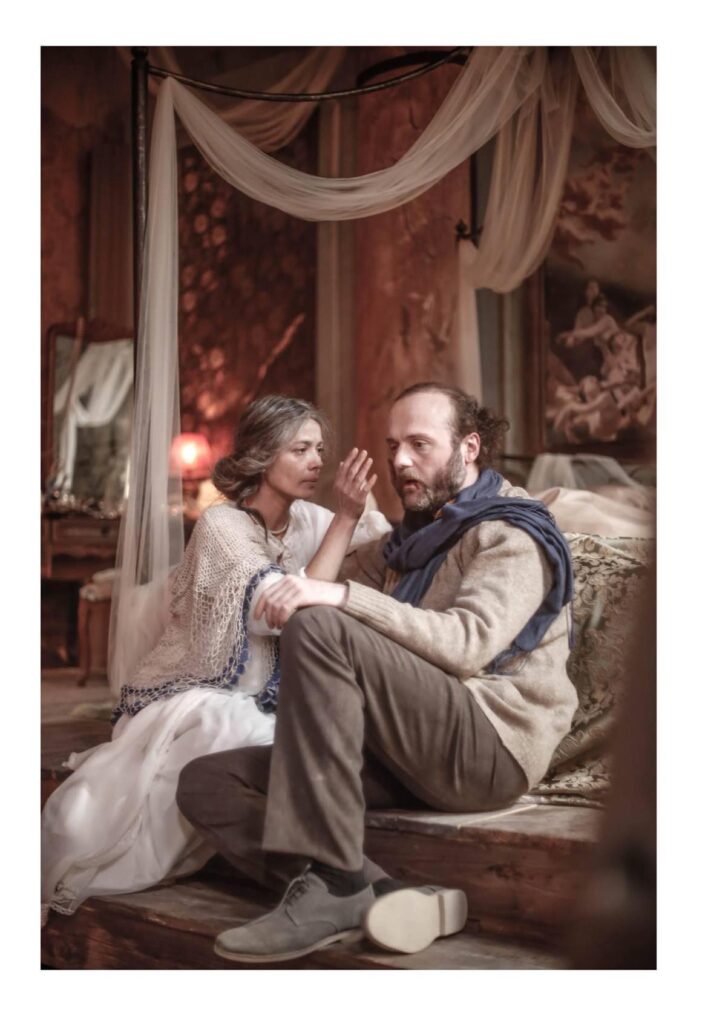A scientific-research institute, which exists by inertia and counts the last days in war-torn, still-at-war and post-Soviet, independent Georgia. The building is ravaged, like the whole country, although it has a strategic location. A group of scientists and soldiers meet in its space. Scientists argue about the futility of existence, and soldiers want to occupy the site to conduct approached combat operations against a seemingly invisible, nameless, mythical and well-known enemy, actually. In the country of wiped out frames and dimensions. In a seemingly defined but abstracted time and situation, at the background of concrete, "grounded" and at the same time multi-layered and deep events.
At the age of 83, Rezo Esadze (who is actually associated with the existence of "other" and unique Georgian cinema) shot a two-hour feature film "A Month as a Day" (2016, Lakumi Studio, funded by the Georgian National Film Center) by Amiran Dolidze's script, together with co-director Lasha Mindiashvili (13 years after the creation of the previous film, "Ceiling" and 4 years before his death) and ended his creative life with this firework, monumental film.
The main character - Marlen (Dato Beshitaishvili) is a middle-aged man, a scientist, seemingly accustomed to reality and fate, fearless, emotionless. In the past, a fighter for the country's independence, a leader. He has an internal conflict with the outside world and himself. The prolonged and unsteady rhythm of loneliness and hopeless life...
The metaphorical image of an unknown city. Ugly street sections and deserted micro-neighborhoods. Half-ruined buildings, with dropped plaster, split open and cracked walls. A micro model of the universe. With the traces of its destruction, collapse. Poverty, hunger, misery, fear. Fear of the ghosts of the past, the present and the future. There is a war somewhere, or an imaginary war, or the expectation of the enemy of people obsessed with the war syndrome they have experienced. Many times changed and always changing dimensions - dialogues, places of action, time, action, seasons of the year or weather. The internal connection between reality and conditionality always changes too. The eternal circle of the world, from different perspectives and from different and the same point.
Mindia Esadze's camera creates a panoramic, expressive, visual reflection of this world and the spiritual and physical condition of people that have reached the edge of madness. The camera moves as it "wants," captures what "strikes" into the lens, and stops on this or that object or detail as long as it considers it "necessary." As if chaotically, randomly and without rules.
The queue for bread. Endless waiting. Many lines and several dozen characters, whose number is gradually increasing. Each has an important place and function. A crowd of individuals, whose image, condition, mood, and position are always changing. And, among them only several preserve dignity and individuality. Generalized images with different features, full-blooded and full-fledged with a number of characteristic signs and character traits. Recent history of Georgia and spiritual portrait of Georgian society.
Women. Men. Youth. Bottoms. Ex-communists, who carry party mandates in their pockets and depend on the possible presence or absence of the enemy (who is not an enemy to them), sometimes sing the anthem of independent Georgia and sometimes sing the anthem of the Soviet Union.
Marlen is freed from the captivity of the past, as well as from the violence of aggressive present that is on the abyss, and from the false illusions of an uncertain future, he protests and takes action.
People from other times also enter the modern reality - real and generalized prototypes of characters - Galaktion, a gray-haired man with the coat of arms of the First Republic of Georgia on his papakha hat and shirt, and various familiar or unknown symbol-types from the distant and recent past of Georgia.
The mob, led by an aggressive pseudo-leader, physically attacks them, Marlen, and the young man (a metaphor for the modern, unruly generation), who confronts the discredited society with him.
Marlen's mentally ill mother (Ia Sukhitashvili) awaits him at home; she has a face of the woman who her son loves. She is identified with her by the age difference. Mother - as a mother and as a metaphorical image, exists in the imaginary world. Where past, present, reality and fiction meet- like the film's structure system and atmosphere. Continuity in time and the dizzying ritual of replacing "living" reality with conditional reality.
The film is created and filled by a strange montage structure of the events development, reaching the edge of madness, and unusual plastic dramaturgy, fragmented, differently accented details, uneven fragments, which, on the one hand, seem to erase and destroy the real dimensions and move to completely unexpected angles and flatness.
Rezo Esadze's "A Month as a Day" is a large-scale film about the history of Georgia, the essence of modern man, feelings, passions, contradictions, the search for losses and re-cognition of the world, the spiritual state of a crippled society and a person deprived of soil, changing moods and the most difficult labyrinths of a country standing at a crossroads. A vast panorama of creative research and artistic analysis, the boundaries of which are as elusive and scattered in space as the infinity of the outer space.
Lela Ochiauri,
PHD in Art Criticism (Film Studies),
WHERE BOUNDRIES OF TIME AND SPACE WIPE OUT






